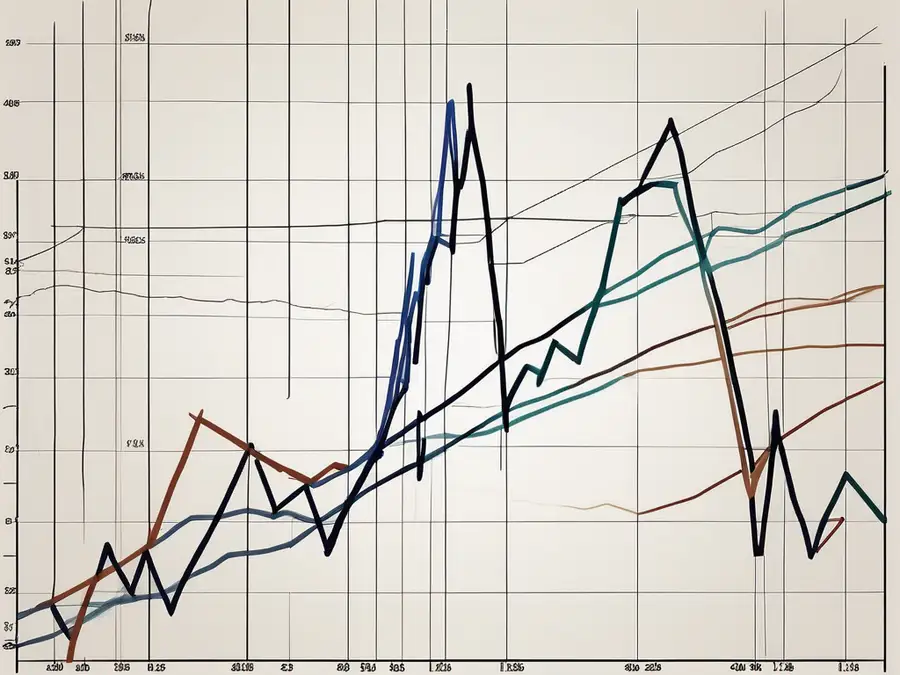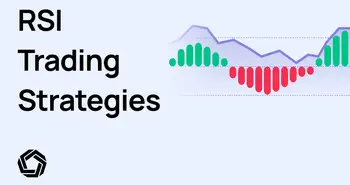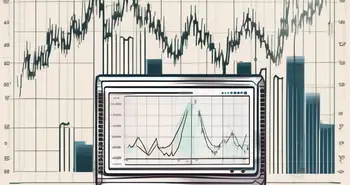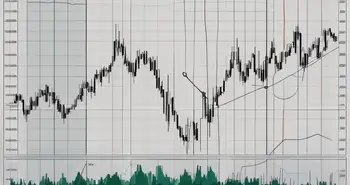The Convergence of RSI: A Detailed Study

As a seasoned trader with years of experience in the financial markets, I cannot stress enough the importance of understanding the concept of RSI and its convergence. RSI, or Relative Strength Index, is a widely used technical indicator that provides valuable insights into the strength and momentum of a financial asset. In this comprehensive analysis, we will delve into the definition of RSI, its role in trading, the concept of convergence, the mathematical framework behind RSI convergence, and the implications of RSI convergence on market trends and investment decisions. Let's begin our journey by unraveling the definition of RSI itself.
Understanding RSI and Its Importance
RSI, in its simplest form, is a momentum oscillator that measures the speed and change of price movements. It ranges from 0 to 100 and is typically displayed as a line graph below the price chart of an asset. This indicator helps traders identify overbought and oversold conditions, as well as potential trend reversals. By analyzing RSI, traders can gain valuable insights into the market sentiment and adjust their trading strategies accordingly.
RSI is a widely used technical indicator in the financial markets. It provides traders with a quantitative measure of the strength and direction of price movements. The concept of RSI was developed by J. Welles Wilder, a renowned technical analyst, and it has since become a staple tool for traders across various financial markets.
Definition of RSI
The Relative Strength Index, developed by J. Welles Wilder, compares the magnitude of recent gains to recent losses, which is then plotted on a 0 to 100 scale. The formula for calculating RSI involves a ratio of the average gain to the average loss over a specified period. A higher RSI value indicates a strong uptrend, while a lower RSI value suggests a potential downtrend.
Calculating RSI involves several steps. First, the average gain and average loss over a specified period are calculated. Then, the relative strength (RS) is determined by dividing the average gain by the average loss. Finally, the RSI is calculated by converting the RS into a 0 to 100 scale using the following formula: RSI = 100 – (100 / (1 + RS)). This process allows traders to visualize the strength of price movements and make informed trading decisions.
The Role of RSI in Trading
RSI plays a crucial role in trading by highlighting potential entry and exit points. Traders commonly use RSI to identify overbought conditions, which occur when the indicator reaches or exceeds the 70 level, suggesting that a price correction is likely to occur. Conversely, oversold conditions are identified when RSI falls below the 30 level, indicating that the asset may be undervalued and a potential buying opportunity arises. By combining RSI with other technical indicators or chart patterns, traders can significantly enhance the accuracy of their trading decisions.
Moreover, RSI can also be used to identify divergences between price and the indicator. Bullish divergences occur when the price makes lower lows while the RSI makes higher lows, indicating a potential trend reversal to the upside. On the other hand, bearish divergences occur when the price makes higher highs while the RSI makes lower highs, suggesting a potential trend reversal to the downside. These divergences can provide valuable signals for traders to anticipate changes in market direction.
It is important to note that RSI is not a standalone indicator and should be used in conjunction with other technical analysis tools. Traders often combine RSI with trendlines, moving averages, or other oscillators to confirm signals and increase the probability of successful trades. Additionally, RSI can be applied to different timeframes, allowing traders to analyze short-term or long-term trends depending on their trading strategies.
In conclusion, RSI is a powerful tool for traders to assess the strength and direction of price movements. By understanding RSI and its interpretation, traders can make more informed trading decisions and improve their overall profitability in the financial markets.
The Concept of Convergence in RSI
In the world of technical analysis, convergence refers to a situation where RSI and price movements move in the same direction, reinforcing the strength of a trend. Understanding convergence is vital for traders as it provides additional confirmation of the trend and can help filter out false signals.
Explaining Convergence
Convergence occurs when the price of an asset forms higher highs while RSI simultaneously forms higher lows in a bullish trend. In a bearish trend, convergence is identified when the price of the asset forms lower lows while RSI simultaneously forms higher highs. These patterns suggest that the momentum is building in the direction of the prevailing trend, indicating a higher probability of the trend continuing.
Let's take a closer look at an example to better understand how convergence works. Imagine a stock that has been steadily rising over the past few weeks. As the price of the stock reaches new highs, the RSI, which measures the strength of the trend, also shows higher lows. This convergence between the price and RSI indicates that the upward momentum is intact and likely to continue. Traders who recognize this convergence may see it as a signal to enter or maintain a long position in the stock, anticipating further price appreciation.
On the other hand, in a bearish trend, convergence can also provide valuable insights. Suppose a cryptocurrency has been experiencing a downtrend, with the price consistently making lower lows. However, during this period, the RSI starts forming higher highs. This convergence between the price and RSI suggests that the selling pressure may be weakening, and a potential reversal or consolidation could be on the horizon. Traders who spot this convergence might consider adjusting their positions or even looking for opportunities to enter a long position if they believe the trend is about to reverse.
How Convergence Relates to RSI
Convergence in RSI acts as a powerful confirmation tool for traders. When an asset's price and RSI begin to converge, it implies that the prevailing trend is gaining strength. This convergence can be seen as a signal to enter or maintain a position in the direction of the trend, increasing the chances of a profitable trade. Additionally, convergence can help traders avoid potential false signals that may occur due to temporary price fluctuations.
It is important to note that convergence should not be the sole factor in making trading decisions. Traders should consider other technical indicators, fundamental analysis, and market conditions to make well-informed decisions. However, when used in conjunction with other tools, convergence in RSI can provide valuable insights and enhance trading strategies.
Furthermore, convergence can also be used in combination with other technical analysis techniques, such as trendlines or moving averages. By identifying convergence along with these other indicators, traders can strengthen their analysis and increase their confidence in the potential outcomes.
In conclusion, convergence in RSI is a concept that traders should pay attention to when analyzing trends in financial markets. It provides additional confirmation of the prevailing trend and can help filter out false signals. By understanding and utilizing convergence effectively, traders can improve their decision-making process and increase their chances of successful trades.
The Mathematical Framework Behind RSI Convergence
Now that we have explored the concept of convergence, it's important to understand the mathematical framework that underlies RSI calculation and convergence analysis. By grasping the mathematical foundations, traders can fully harness the power of RSI convergence.
The Calculation of RSI
The calculation of RSI involves a series of steps. Firstly, the average gains and average losses are computed over a specific period, commonly 14 days. The relative strength (RS) is then calculated by dividing the average gain by the average loss. Finally, RSI is derived from RS using the formula: RSI = 100 – (100 / (1 + RS)). This calculation allows traders to quantify the strength of a trend and identify potential convergence patterns.
Understanding Convergence through Mathematics
To identify convergence, traders need to scrutinize the relationship between price movements and changes in RSI values. By analyzing the momentum of an asset and comparing it to RSI, traders can determine whether convergence is present. Through mathematical analysis, traders gain a deeper understanding of the underlying dynamics of RSI convergence and can exploit this knowledge to make informed trading decisions.
The Implications of RSI Convergence
RSI convergence carries significant implications for market trends and investment decisions. By recognizing and acting upon convergence patterns, traders can gain an edge in the financial markets.
The Impact on Market Trends
Convergence in RSI can signal the sustainability and strength of a market trend. When RSI and price movements are in harmony, it suggests that the prevailing trend has a robust foundation and is likely to continue. Traders who accurately identify convergence patterns can position themselves to take advantage of trends and maximize their trading profits.
RSI Convergence and Investment Decisions
RSI convergence is a valuable tool for making sound investment decisions. When traders observe convergence, it indicates the potential stability of a trend, which can guide long-term investment strategies. By incorporating RSI convergence analysis into their investment approach, traders can make informed decisions that align with their risk appetite and long-term financial goals.
Strategies for Utilizing RSI Convergence
Now that we have explored the significance of RSI convergence, it's time to discover practical strategies for incorporating this concept into our trading methodology.
Timing Entry and Exit Points
RSI convergence can assist traders in determining optimal entry and exit points. For example, during a bullish convergence pattern, traders may consider entering a long position when RSI and price movements align and the convergence gains momentum. Conversely, during a bearish convergence pattern, traders could explore short-selling opportunities. By using RSI convergence as a timing indicator, traders can fine-tune their entries and exits, maximizing their profit potential.
Risk Management with RSI Convergence
In addition to timing entry and exit points, RSI convergence analysis plays a vital role in risk management. By closely monitoring RSI and price convergence, traders can set appropriate stop-loss levels and manage their risk. If the convergence pattern begins to weaken or break down, it may indicate a potential trend reversal, prompting traders to exit their positions and mitigate potential losses.
As a seasoned trader, I have witnessed firsthand the power of RSI convergence in shaping my trading strategies and decision-making process. One piece of advice I can offer is to practice patience when analyzing convergence patterns. While convergence can provide valuable insights, it is important to wait for confirmation before placing trades.
Frequently Asked Questions (FAQ)
What is RSI?
RSI, or Relative Strength Index, is a widely used technical indicator that measures the speed and change of price movements. It ranges from 0 to 100 and helps traders identify overbought and oversold conditions, as well as potential trend reversals.
How does convergence relate to RSI?
Convergence in RSI occurs when the price of an asset and RSI move in the same direction, reinforcing the strength of a trend. It provides confirmation of the trend and helps filter out false signals for traders.
What are the implications of RSI convergence?
RSI convergence suggests the sustainability and strength of a market trend. Traders who accurately identify convergence patterns can position themselves to take advantage of trends and make informed investment decisions.
How can I utilize RSI convergence in my trading strategies?
RSI convergence can be utilized by timing entry and exit points based on convergence patterns. Additionally, it aids in risk management by setting appropriate stop-loss levels and monitoring potential trend reversals.
In conclusion, the convergence of RSI is a powerful concept that holds great significance for traders in the financial markets. By understanding RSI, recognizing convergence patterns, and incorporating them into trading strategies, traders can gain an edge and make more informed trading decisions. Remember, always stay vigilant and patient when analyzing convergence, and let the power of RSI convergence guide your path to trading success.
Ready to elevate your trading strategies with the power of RSI convergence? Discover the future of investing with Morpher, the revolutionary platform where you can leverage the insights of RSI convergence across a multitude of markets without the burden of fees. With Morpher, you can trade with infinite liquidity, enjoy fractional investing, and experience the security of a non-custodial wallet. Whether you're looking to capitalize on market trends with up to 10x leverage or explore innovative Virtual Futures, Morpher is your gateway to a unique trading experience. Sign Up and Get Your Free Sign Up Bonus today, and join the community of traders who are already shaping the future of investing.

Disclaimer: All investments involve risk, and the past performance of a security, industry, sector, market, financial product, trading strategy, or individual’s trading does not guarantee future results or returns. Investors are fully responsible for any investment decisions they make. Such decisions should be based solely on an evaluation of their financial circumstances, investment objectives, risk tolerance, and liquidity needs. This post does not constitute investment advice.

Painless trading for everyone
Hundreds of markets all in one place - Apple, Bitcoin, Gold, Watches, NFTs, Sneakers and so much more.

Painless trading for everyone
Hundreds of markets all in one place - Apple, Bitcoin, Gold, Watches, NFTs, Sneakers and so much more.









